Game of Thrones is over. It hurts. Both because it was a staple of our lives we all loved and enjoyed together for over eight years, and also because after a ground breaking, impossibly good, world phenomena series run, they kinda stuck the landing like…

(X) Writing is hard, guys.
But I’m not here to talk about that, because, well, the Memes pretty much have that covered. I’m here to talk about something Game of Thrones did really, really right (well, for the most part):
Arya and Sansa Mother Fucking Stark.
Game of Thrones (and I will be dealing exclusively with the television series here) was at its best when it was subverting traditional storytelling tropes. Think of your favorite moments in the series. Battle of the Bastards? That’s the moment where Jon has his big warrior stand against an incoming army, only to get trampled and be engulfed by the confusion, chaos, and absolute destruction of a battle instead of the glorious, swelling heroics we subconsciously expect. Or how about when Ned died? When you were trying to figure out how this (supposed) anchor character was going to get out of this impossible hole he found himself in, only to find that he wasn’t. The Red Wedding? The Septa Balor? The birth of Dany’s dragons? All moments that went against what our brains have been programmed to expect from traditional storytelling, and yet fit into the larger narrative being spun just for us better than those expected moments would have.
Sansa and Arya are no exception, and their storylines are inextricably connected. Yes, they start as diametric opposites. Sansa is the beautiful, traditional, Lady-in-Training, and Arya is the tomboy fighter who doesn’t fit into her prescribed social role. They are bound by their shared home, name, and family, but also by another unifying trait.
They’re both Disney princesses.

I do mean specifically “Disney” princess, too. Not just because, well, I gotta stay on brand, but because they fit the Disney princess tropes. After all, in our modern conscious, the “princess” tropes and “Disney princess” tropes have become synonymous. And, as any Disnerd knows, royal lineage is often the last criteria considered when classifying a Disney princess. It’s about the common character traits and journeys they share.

So how are Sansa and Arya both Disney princesses, when their personalities and journeys are so starkly (heh) different? Simple. Sansa is the traditional 50’s era* Disney princess – i.e. Snow White, Cinderella, Aurora – and Arya is the 90’s era Disney princess – Ariel, Belle, Jasmine, Mulan, Esmerelda, etc.
*Yes, Snow White came out in 1937, but we’re simplifying and generalizing here, people.
Sansa’s beauty – although not her defining characteristic – is the trait preeminently commented on by other characters in the show. Just like the OG princesses, whose beauty is always mentioned in the opening prologue and then often used to motivate the villain.


She is quiet, demure, and accomplished at the domestic arts. “You’re perfect, aren’t you?” comments Cersei scathingly, as Sansa prays with the ladies of King’s Landing during the Battle of Blackwater.


And her greatest wish is to leave her current living situation to marry a handsome prince.


David Benioff even alluded to this comparison in one of the Season One “Inside the Episodes.” We’ve never discussed Arya in relation to Disney princesses, though. Perhaps because, to the uninitiated, calling a character as badass as Arya a “Disney princess” seems like sacrilege. However, the enlightened know that Disney princesses got a massive reboot in the 90’s.
They became headstrong, capable, but repressed women who didn’t fit into the prescribed social role their fathers picked for them.


They went on long, treacherous journeys, and sacrificed parts of themselves in order to achieve a goal they had from the beginning.


Whether they fought with words or weapons, they became warriors against those they thought did harm. They fought with their own intelligence and learned experiences, sometimes with the help of a more feminine weapon.


And while it’s often not her main motivation, there is always an attractive romantic interest she meets somewhere along the way on her journey (again, dealing with 90’s princesses, not later).

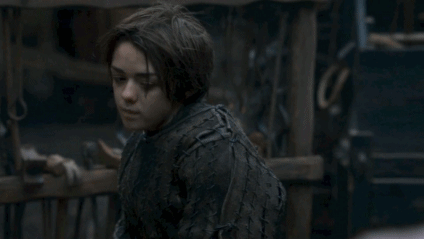
So we have two main tropes of our standard Disney princesses. The Strong Independent Lady On a Quest (To Marry a Prince) and The Beautiful Saint in Trouble (Until She Marries a Prince). But it’s Game of Thrones. So things take at turn for the Starkly darkly.
Turns out Sansa’s original living situation wasn’t so terrible, and the prince who comes to save her from her old life is actually the cause of the greatest miseries imaginable.

Arya doesn’t achieve her goals by making friends with talking teapots or getting a guy to kiss her, but by becoming an unstoppable, avenging, killing machine.
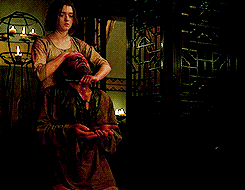
The cool thing, though, is that as their stories progress, despite how dark and twisted their stories become, they don’t eschew these “princess” qualities. They actually use them to their advantage.
Sansa: The Awakening Beauty
Sansa arguably has a fairly traditional 50’s princess journey. She is the perfect, quiet, idealistic, domestic beauty whose life is turned upside down by the machinations of others. Unlike most characters, Classic 50’s princesses aren’t active agents in their stories. They don’t seek out things: things happen to them. Snow White’s stepmom/head of state sends a hit-man after her. Cinderella’s father dies and leaves her in an abusive home. Aurora is hunted by a (badass) maniac with magical powers.

Likewise, Sansa’s story arc for the majority of the show is the result of the machinations of others, and has little to do with her own choices and actions. Ned and King Robert decide to betroth her to Joffrey the Human Version of Menstrual Cramps. She was orphaned, imprisoned, betrothed, married off, and made part of a regicide entirely at the hands of others. Even a moment that seemed like her own doing – the knight-turned-fool offering her a necklace and escape plan because of her earlier kindness – was actually the machinations of Littlefinger and Lady Olenna.
It is notable that 50’s princesses, despite all the trauma that happens to them, never change from their original, unflappable, naive, idealistic, poised, beautiful, perfect selves.
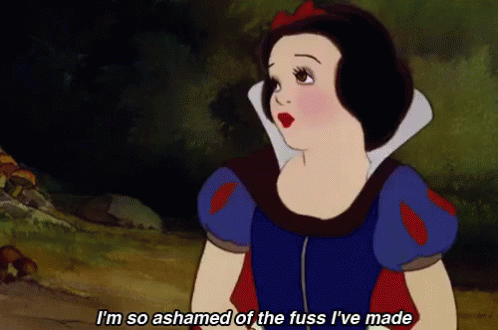
However, Game of Thrones is very much not a fairy tale. At its best, it takes fantasy/fairy tale situations and applies real life consequences to them. And in real life, significant life events – especially traumatic ones – change you for better and for worse. This is what I found so damaging about Disney’s version of Cinderella. We don’t see how these (female) characters’ domestic abuse, violence, and trauma affect their ability to remain “perfect.” Enter Sansa.
The major subversion of Sansa’s Classic Princess storyline is that we actually watch her struggle and suffer, internalize and evolve. She doesn’t stay as innocent, naive, and “perfect” as she once was, as a typical 50’s princess would.

But, ironically, beautifully, she continues to play the part of the Perfect Princess, even though it is easy to see her words are divorced from her internal thoughts and feelings. In fact, she turns these notably uber feminine, 50’s princess traits into her surreptitious weapons.
Showing an extreme amount of emotional intelligence, Sansa pretends to be guileless, obedient, and amenable, because it’s the only thing that keeps her from being killed or further tortured.
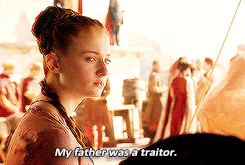
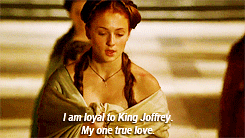

Sansa never becomes a physical fighter, but her needle becomes as much a weapon as Arya’s sword Needle. She sews clothes that show her authority to the Northmen in later seasons and she makes a cloak for Jon that helps mend bridges between her and her now-powerful-but-loving, estranged brother. Most notably, in a watershed moment for her character, she makes a dress that turns her own beauty against Littlefinger, who seeks to use and control her beauty for himself. But, in the end, Sansa uses it against him as a weapon on its own. Something, it seems, Littlefinger did not anticipate as fully as he should – the one scenario he did not plot out in his mind.
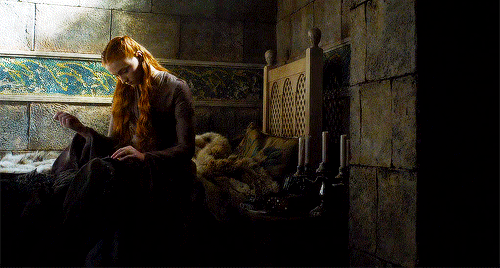


That’s because these weapons are so subtle, and so feminine, they are missed by most of the men seeking to control Sansa. She becomes thoroughly underestimated. So she is allowed to observe and gather herself and her strength, so that she can finally unleash herself once she’s finished her education and able to take control of the game herself.


In the end, Sansa has learned and grown so much, she arguably plays the game better than anyone else in the show.
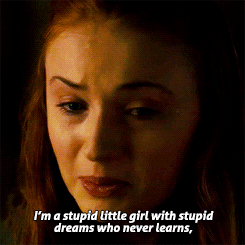


The fairy tale story dictates that Sansa should have been carried off by a prince, far away from her troubles, as long as she remained sweet, pretty, and thoroughly unflappable. But Sansa achieved what she did not because she wasn’t, er, flapped, but because she had an immense inner strength that helped her to grow from her horrific experiences (which is what I think the writers tried and failed to convey in that disastrous “it’s great I was raped” speech). Sansa learned that these fucked up princes – who would take her away with a kiss – were not her salvation, but her obstacles. For six seasons, Sansa freezes like a statue as threatening, unwanted men kiss her on the mouth. Until, finally, when Littlefinger tells her he wants to rule Westeros with her by his side – effectively if hypothetically offering her the dream she had in season one – and he leans in to kiss her once more, she puts her hand out, and gently but firmly stops him.

It’s still a quiet move. There aren’t big speeches or stab wounds. But it’s another major turning point for her character. She finally has gained the power she needs to make choices for herself – something her narrative was never supposed to allow her. But Sansa found a way. So her story ends, not with someone carrying her off to yet another land or castle – as she once hoped Loras Tyrell would have done – to solve her problems with another proposed marriage, but with Sansa making the active decision to plant herself resolutely and singularly in the North, the place the little princess first dreamed of being rescued from. She rules there as Queen Regent in her own right, without any marriage or other male alliance putting her there.* And she does it with the help of those feminine, decorous characteristics we associate with the original 1950’s Disney princesses. But with a very, very welcome divergence. She learned, she changed, and she made the choice herself.


*You could argue Jon Snow helped elevate her, but you could also argue he stood in her way just as much, and in the end, she proved herself as a leader to the Northerners while Jon was off banging his aunt on a boat, and then she secured the independence of the North and was coronated while he was growing a beard in a cell, so I stand by my point.
**You could also argue that Bran helped but, c’mon, who has Bran ever helped?
Arya: A Princess Has the Darkest Timeline
Arya arguably has a fairly traditional 90’s Princess Hero/ine’s Journey. She leaves her home to achieve a goal. She journeys far, faces many setbacks and obstacles, learns new things that help her overcome those obstacles, and then eventually achieves her goal. Except, instead of said goal being to avoid an arranged marriage, save her father, or grow legs and a vagina, Arya’s goal is to cut off the faces of people she’s placed on a kill list so she can wear them as a skin while she kills more people on said kill list. While smiling.

I knew there was a reason Arya was always my fav.
Well, at least, that’s the goal that drives her Hero’s Journey, but that’s born out of her trauma. Arya’s actual, core desire/super-objective (the thing she would sing an “I Want” song about) is more abstract and intangible, like Belle’s from Beauty and the Beast. She wants to live a life that is true to her own self, and not the one that is socially mandated to her. Mayhaps that life will involve murdering terrible people and baking them into pies, who knows?

This is actually fairly typical of 90’s princesses. The desire that catalyzes their journey is secondary to their deeper, inner drive. Yes, Ariel wants to marry that dude she just met and never spoke to, but that’s because of her deeper desire to live on land. Mulan leaves home to rescue her father, but the conflict driving her story is her struggle to find her true inner self.
It is notable of 90’s Disney princess story arcs that, like 50’s princesses, their character and motivations rarely change. While, unlike 50’s princesses, they grow and learn over their journey, of which they are the active agents, they nonetheless don’t go through many radical transformations (as for instance, the Beast of Beauty and the Beast or Elsa of Frozen does). No key character traits are altered. It’s more about their journey to find the thing they wanted all along.
Likewise, in the end, Arya more or less returns to where she started, with a powerful lord offering her a life as a lady of a great house, to whom she easily says no, because she wants more than that provincial life. She responds with the phrase that could easily be Arya’s thesis statement: a constant thread in the beginning, middle, and end of her story.


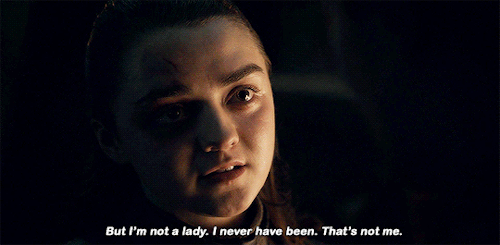
However, the biggest subversion here, besides, y’know, the cold-blooded killing part, is that, unlike those other modern Disney princesses, Arya does undergo a lot of character change, and then has to learn how to find her way back to the person she was at the beginning of the story, before she can truly achieve the goals she started with.
Despite what those movies suggest, when you lose so much, journey so far, and fight so hard for a single goal, it’s impossible not to change. Granted, the last leg of Arya’s arc, when she decides to give up vengeance for good, was, ahem, a little rushed (for elaboration, I once again direct you to Memes), but Arya’s overall journey was a tricky balance of achieving her goals, learning things that changed her, and learning things that helped her retain and return to her core. And those core traits? Yup. Classic 90’s princess traits.
Like those princesses, Arya is active, capable, bullheaded, and impulsive. More importantly, though, Arya cares deeply about justice, and even goodness. She never wanted cruel people to get ahead. She cared more about Micah the Butcher’s Boy than any royal family member, because he was kind and her friend. She risked her life, and her quest to become a faceless assassin, simply because the stranger she was ordered to kill didn’t deserve to die. And, unlike Sansa and the 50’s princesses, she’s not one to keep those opinions to herself.



It was these personality traits that led her to betray the Faceless Men and begin her journey home, but they’re also the traits that the House of Black and White most effectively dampened and nearly erased. They successfully taught her to never betray emotion, to move silently, methodically, and to act as a servant to the Many Faced God, whether his commands were just or not. It shows how much of herself Arya lost that she found herself genuinely conflicted over whether or not to kill Lady Crane, the kind Leading Player whose only call to death was another woman’s ambition and greed. In the end, her sense of justice, dampened but not extinguished, won out, and Arya betrayed the House of Black and White, warned Lady Crane, and effectively exiled herself from The House of Black and White and placed herself on their own kill list. It’s her first step towards regaining herself after becoming No One, a process furthered by reuniting with important people from her past. Hot Pie reminds her of friendship and human connection, and helps Arya (impulsively) decide to reverse course and return home. The Hound alerts her to how much she’s changed (“You never used to shut up, now you’re just sitting there like a mute”). Gendry reminds her of *other* forms of human connection, and his presence motivates her to take more bold and impulsive/emotional actions. Most importantly, Nymeria, her long lost direwolf, reminds her of that fundamental, core desire to forge her own path: “That’s not you/me.” Slowly, a girl starts to become Arya Stark again.
But the most important thing that led Arya back to Winterfell, her home, and her true self, was her devotion to her family – another hallmark of a 90’s Disney Princess.



Arya’s main drive on her journey – vengeance – comes entirely from a love of her family. When she isn’t able to protect them, as their descendant Tony Stark would have said, “you can be damn sure she’ll avenge them.” And when that Disney Princess feeds Lord Frey the remnants of his dead children while wearing the face of a woman she killed, she makes damn sure that Walder knows it’s a Stark that’s smiling down on him as he dies. “I hate heroes,” she later tells the Hound as they leave Winterfell for King’s Landing for the final battle, when he asks why she’s not enjoying the adulation due to the Hero of Winterfell. She stabbed the Night King so he didn’t kill her and the ones she loved. She became a killer out of love (and grief and anger) for her family, not for glory, or even blood lust. Like a true princess.
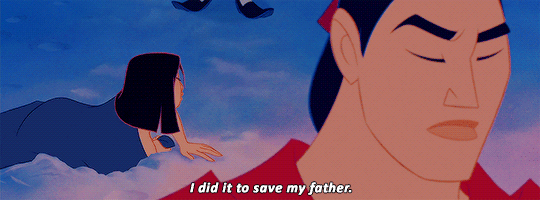
She begins to lose sight of that at The House of Black and White. After all, No One has no family. But it’s arguably that love of family that keeps Arya from ever being in danger of completely losing herself, since, when purging herself of the possessions of Arya Stark, she couldn’t bring herself to throw away Needle, the sword her brother made for her. It’s that connection to her family that allows Arya to regain her identity and return to Westeros. At the same time, the seeds of suspicion and hyper-vigilance planted by the House of Black and White almost cause Arya to break irreparably with her closest remaining family, her sister Sansa, when she returns home to Winterfell. Arya has to learn and decide to trust Sansa, and subsequently Arya becomes Ride or Die for the Stark she always struggled to connect with. When Arya bridges that last gap that exists (and always existed) between her and her family, she looks more comfortable in her own skin than ever, and we don’t see her wear a different face again.

Because it’s only after Arya has reconnected these parts of herself, when she returns to her very beginning of her journey, standing with a figure from a foreign land who offers to fend off certain death so that she can run towards her destiny, and who asks the question…

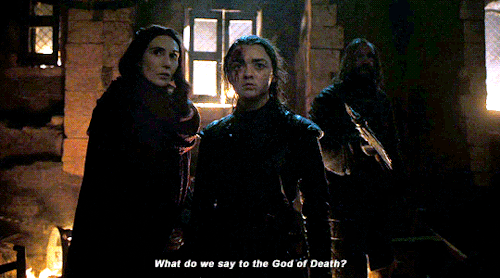

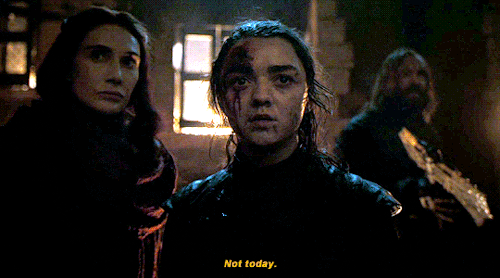
…can Arya claw her way back to the core character she was at the beginning of this story, and successfully complete the 90’s princess story arc she began eight seasons ago. But, y’know, while still keeping those darker, subversive twists. She kills the Night King (something 90’s princesses typically don’t do), rejects the love interest who would lead her away from her goals (something 90’s princesses definitely don’t do), and sets off on an adventure to literally chart her own path towards unmapped territory. Just as she would have wanted in season one. Sailing on a ship away from lords, ladies, sewing needles, and even vengeance, to find adventure in the great wide somewhere.

Presumably accompanied by her bag full of faces. But with a direwolf sigil on her sails. While her sister Sansa protects the family and the North, sitting on her throne in Winterfell, ending her princess journey far from where she started, even though she’s the one in the same physical space. Two happy endings very hard won, connected and diverging. Cuz it doesn’t matter what kind of princess you are, as long as you own it with everything you got.


And those are the Disney princesses we always deserved.








